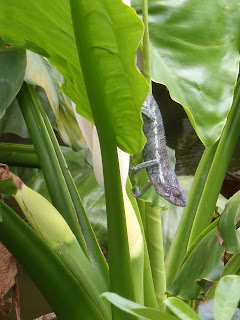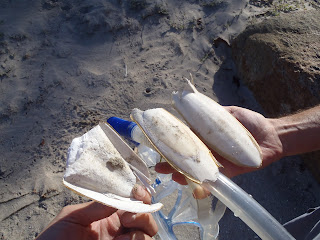Happy New Year, everyone! As I have not had consistent access to internet for a while, some of these posts are a little backlogged. Tim and I took a lovely trip around Northern Madagascar together and visited several national parks and other interesting places along the way. Now that I'm back online, I can tell you all about it :)
The first day of our trip, we were supposed to fly up to Antsiranana (also known as Diego Suarez), on the Northern end of the island. Instead, Air Madagascar messed up our flight and after much confusion and a night in the capital Antananarivo, we made it to Diego early the next morning.
My first impression was that Diego is a much bigger, much more developed city than I expected. It had beautiful wide boulevards lined with the red flamboyant-flower trees, as well as some beautiful yellow trees. The buildings were old French colonial buildings, now decadent and in some disrepair; one unoccupied building in particular, with trees growing in a courtyard where once there had been a roof, added a lot of character to the city.
The city streets were perpendicular, and many shops opened their doors onto the ample sidewalk. I mention this because most "cities" in 3rd world countries have no planning: roads go every which-way and everyone is allowed to use them (pedestrians, cattle-carts, cars, semis, dogs, and playing children alike). So this felt like a small breath of civilization.
Diego is situated on a series of 3 bays, and the sad part of the town setup is that there really is no easy beach access. But this is a blessing in disguise because we visited 2 of the 3 bays, and found hardly anyone there, and not a single piece of trash! (Compared to Fort Dauphin, in the south, where the beach is the largest public dump and largest public restroom!)
First we visited Ramena, the beach that is the launching point of the boat that goes to Emerald Bay, the largest tourist attraction in the area. Ramena seemed cute at first- little huts roofed with palm leaves that served lunch of grilled shrimp brochettes, fishermen hauling in their catch, children splashing in the water. But after a few minutes it became clear that there was an unbalance in the population: we only saw old white men (no locals) and beautiful young women (no foreigners except me). Sexual tourism was rampant and occurring right in front of our eyes. A girl would sit at a table at one of the little lunch huts, and wait for a creepy old guy to sit down and buy her a meal, before the two left together. Over the course of our lunch we saw this happen with maybe 6 girls. We even witnessed a fight: what I could gather between the shouting and language differences was that a girl was owed some money from a customer who now sat with a different girl, and she threw a tantrum. He gave her some hush money, which was not enough, and she ran, yelled, and cried along the beach until some other girls had to carry her away. Drama!!
So after that whole mess, and before we were approached (because at this point I'm fairly certain that had I not been present, these girls would have descended like a pack of wolves on Tim), we split and went to the Sakalava bay.
Sakalava was pristine, and but for a few families enjoying quiet picnics, was completely empty. We walked all along the edge of the bay and over this hill to a view of gorgeous turquoise water.
On the land behind us in the photo, we think are several large headstones, as the Malagasy typically bury people facing the water. Couldn't imagine a more peaceful place to spend eternity!
Here we also saw what is portrayed on a lot of postcards: women wearing a yellowish face paint, to protect their skin from the sun. This lovely lady was kind enough to let me take her picture. I took one photo, then Tim called her "apelasoa" (pretty woman), and she shyly giggled as I took this candid shot.
All in all, Diego offered a relaxing start to our vacation, and I would like to go back to enjoy a little more of what the city has to offer, as well as visit that 3rd bay!!
The first day of our trip, we were supposed to fly up to Antsiranana (also known as Diego Suarez), on the Northern end of the island. Instead, Air Madagascar messed up our flight and after much confusion and a night in the capital Antananarivo, we made it to Diego early the next morning.
My first impression was that Diego is a much bigger, much more developed city than I expected. It had beautiful wide boulevards lined with the red flamboyant-flower trees, as well as some beautiful yellow trees. The buildings were old French colonial buildings, now decadent and in some disrepair; one unoccupied building in particular, with trees growing in a courtyard where once there had been a roof, added a lot of character to the city.
The city streets were perpendicular, and many shops opened their doors onto the ample sidewalk. I mention this because most "cities" in 3rd world countries have no planning: roads go every which-way and everyone is allowed to use them (pedestrians, cattle-carts, cars, semis, dogs, and playing children alike). So this felt like a small breath of civilization.
Diego is situated on a series of 3 bays, and the sad part of the town setup is that there really is no easy beach access. But this is a blessing in disguise because we visited 2 of the 3 bays, and found hardly anyone there, and not a single piece of trash! (Compared to Fort Dauphin, in the south, where the beach is the largest public dump and largest public restroom!)
 |
| The beach in Ft Dauphin- notice the hillside of trash |
So after that whole mess, and before we were approached (because at this point I'm fairly certain that had I not been present, these girls would have descended like a pack of wolves on Tim), we split and went to the Sakalava bay.
Sakalava was pristine, and but for a few families enjoying quiet picnics, was completely empty. We walked all along the edge of the bay and over this hill to a view of gorgeous turquoise water.
On the land behind us in the photo, we think are several large headstones, as the Malagasy typically bury people facing the water. Couldn't imagine a more peaceful place to spend eternity!
Here we also saw what is portrayed on a lot of postcards: women wearing a yellowish face paint, to protect their skin from the sun. This lovely lady was kind enough to let me take her picture. I took one photo, then Tim called her "apelasoa" (pretty woman), and she shyly giggled as I took this candid shot.
All in all, Diego offered a relaxing start to our vacation, and I would like to go back to enjoy a little more of what the city has to offer, as well as visit that 3rd bay!!


















































